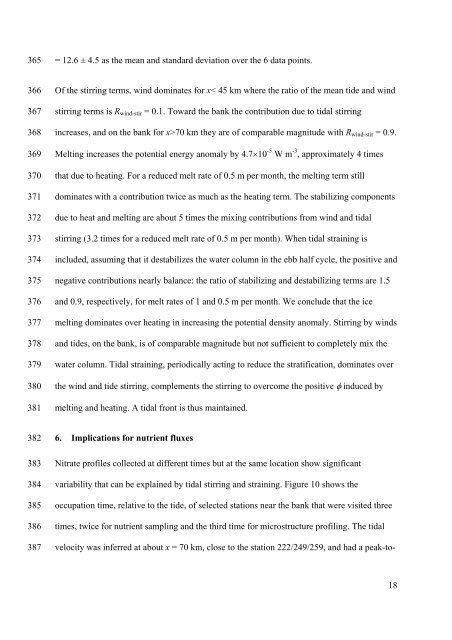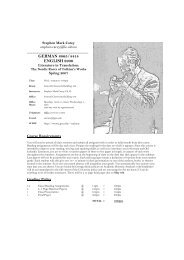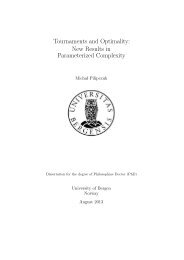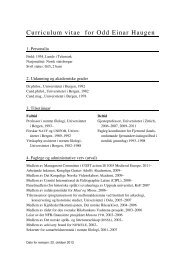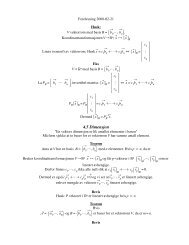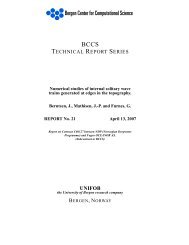Mixing in the Barents Sea Polar Front near Hopen in spring
Mixing in the Barents Sea Polar Front near Hopen in spring
Mixing in the Barents Sea Polar Front near Hopen in spring
You also want an ePaper? Increase the reach of your titles
YUMPU automatically turns print PDFs into web optimized ePapers that Google loves.
365<br />
= 12.6 ± 4.5 as <strong>the</strong> mean and standard deviation over <strong>the</strong> 6 data po<strong>in</strong>ts.<br />
366<br />
367<br />
368<br />
369<br />
370<br />
371<br />
372<br />
373<br />
374<br />
375<br />
376<br />
377<br />
378<br />
379<br />
380<br />
381<br />
Of <strong>the</strong> stirr<strong>in</strong>g terms, w<strong>in</strong>d dom<strong>in</strong>ates for x< 45 km where <strong>the</strong> ratio of <strong>the</strong> mean tide and w<strong>in</strong>d<br />
stirr<strong>in</strong>g terms is R w<strong>in</strong>d-stir = 0.1. Toward <strong>the</strong> bank <strong>the</strong> contribution due to tidal stirr<strong>in</strong>g<br />
<strong>in</strong>creases, and on <strong>the</strong> bank for x>70 km <strong>the</strong>y are of comparable magnitude with R w<strong>in</strong>d-stir = 0.9.<br />
Melt<strong>in</strong>g <strong>in</strong>creases <strong>the</strong> potential energy anomaly by 4.710 -5 W m -3 , approximately 4 times<br />
that due to heat<strong>in</strong>g. For a reduced melt rate of 0.5 m per month, <strong>the</strong> melt<strong>in</strong>g term still<br />
dom<strong>in</strong>ates with a contribution twice as much as <strong>the</strong> heat<strong>in</strong>g term. The stabiliz<strong>in</strong>g components<br />
due to heat and melt<strong>in</strong>g are about 5 times <strong>the</strong> mix<strong>in</strong>g contributions from w<strong>in</strong>d and tidal<br />
stirr<strong>in</strong>g (3.2 times for a reduced melt rate of 0.5 m per month). When tidal stra<strong>in</strong><strong>in</strong>g is<br />
<strong>in</strong>cluded, assum<strong>in</strong>g that it destabilizes <strong>the</strong> water column <strong>in</strong> <strong>the</strong> ebb half cycle, <strong>the</strong> positive and<br />
negative contributions <strong>near</strong>ly balance: <strong>the</strong> ratio of stabiliz<strong>in</strong>g and destabiliz<strong>in</strong>g terms are 1.5<br />
and 0.9, respectively, for melt rates of 1 and 0.5 m per month. We conclude that <strong>the</strong> ice<br />
melt<strong>in</strong>g dom<strong>in</strong>ates over heat<strong>in</strong>g <strong>in</strong> <strong>in</strong>creas<strong>in</strong>g <strong>the</strong> potential density anomaly. Stirr<strong>in</strong>g by w<strong>in</strong>ds<br />
and tides, on <strong>the</strong> bank, is of comparable magnitude but not sufficient to completely mix <strong>the</strong><br />
water column. Tidal stra<strong>in</strong><strong>in</strong>g, periodically act<strong>in</strong>g to reduce <strong>the</strong> stratification, dom<strong>in</strong>ates over<br />
<strong>the</strong> w<strong>in</strong>d and tide stirr<strong>in</strong>g, complements <strong>the</strong> stirr<strong>in</strong>g to overcome <strong>the</strong> positive <strong>in</strong>duced by<br />
melt<strong>in</strong>g and heat<strong>in</strong>g. A tidal front is thus ma<strong>in</strong>ta<strong>in</strong>ed.<br />
382<br />
383<br />
384<br />
385<br />
386<br />
387<br />
6. Implications for nutrient fluxes<br />
Nitrate profiles collected at different times but at <strong>the</strong> same location show significant<br />
variability that can be expla<strong>in</strong>ed by tidal stirr<strong>in</strong>g and stra<strong>in</strong><strong>in</strong>g. Figure 10 shows <strong>the</strong><br />
occupation time, relative to <strong>the</strong> tide, of selected stations <strong>near</strong> <strong>the</strong> bank that were visited three<br />
times, twice for nutrient sampl<strong>in</strong>g and <strong>the</strong> third time for microstructure profil<strong>in</strong>g. The tidal<br />
velocity was <strong>in</strong>ferred at about x = 70 km, close to <strong>the</strong> station 222/249/259, and had a peak-to-<br />
18


